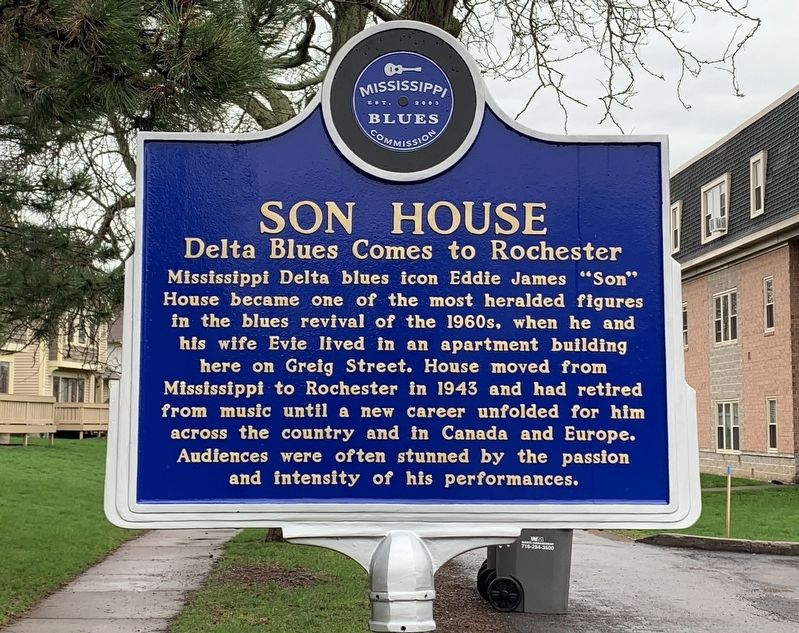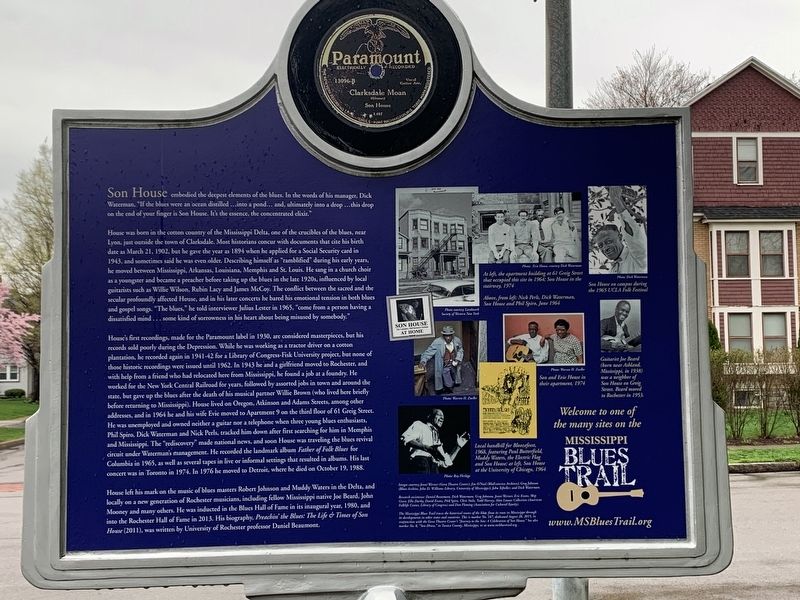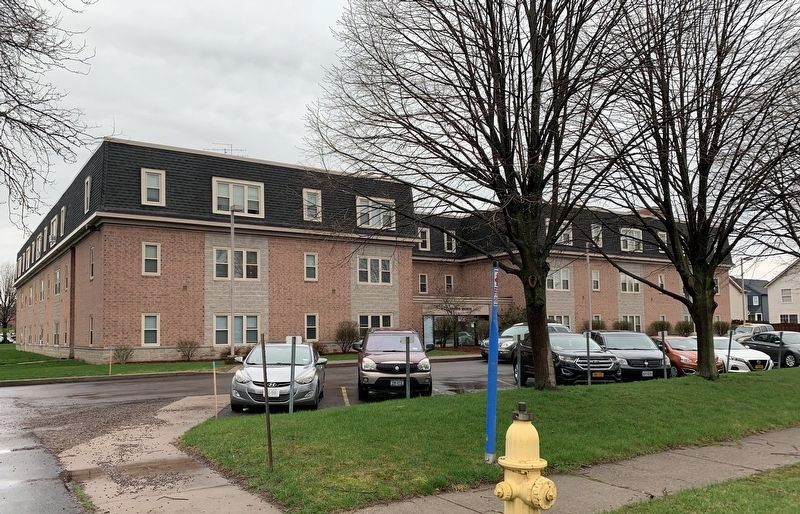Corn Hill in Rochester in Monroe County, New York — The American Northeast (Mid-Atlantic)
Son House
Delta Blues Comes to Rochester
— Mississippi Blues Trail —
[Rear]
Son House embodied the deepest elements of the blues. In the words of his manager, Dick Waterman, "If the blues were an ocean distilled ...into a pond... and, ultimately into a drop ...this drop on the end of your finger is Son House. It's the essence, the concentrated elixir."
Son House was born in the cotton country of the Mississippi Delta, one of the crucibles of the blues, near Lyon, just outside the town of Clarksdale. Most historians concur with documents that cite his birth date as March 21, 1902, but he gave the year as 1894 when he applied for a Social Security card in 1943, and sometimes said he was even older. Describing himself as "ramblified” during his early years, he moved between Mississippi, Arkansas, Louisiana, Memphis and St. Louis. He sang in a church choir as a youngster and became a preacher before taking up the blues in the late 1920s, influenced by local guitarists such as Willie Wilson, Rubin Lacy and James McCoy. The conflict between the sacred and the secular profoundly affected House, and in his later concerts he bared his emotional tension in both blues and gospel songs. "The blues,” he told interviewer Julius Lester in 1965, "come from a person having a dissatisfied mind ... some kind of sorrowness in his heart about being misused by somebody."
House's first recordings, made for the Paramount label in 1930, are considered masterpieces, but his records sold poorly during the Depression. While he was working as a tractor driver on a cotton plantation, he recorded again in 1941-42 for a Library of Congress-Fisk University project, but none of those historic recordings were issued until 1962. In 1943 he and a girlfriend moved to Rochester, and with help from a friend who had relocated here from Mississippi, he found a job at a foundry. He worked for the New York Central Railroad for years, followed by assorted jobs in town and around the state, but gave up the blues after the death of his musical partner Willie Brown (who lived here briefly before returning to Mississippi). House lived on Oregon, Atkinson and Adams Streets, among other addresses, and in 1964 he and his wife Evie moved to Apartment 9 on the third floor of 61 Greig Street. He was unemployed and owned neither a guitar nor a telephone when three young blues enthusiasts, Phil Spiro, Dick Waterman and Nick Perls, tracked him down after first searching for him in Memphis and Mississippi. The "rediscovery” made national news, and soon House was traveling the blues revival circuit under Waterman's management. He recorded the landmark album Father of Folk Blues for Columbia in 1965, as well as several tapes in live or informal settings that resulted in albums. His last concert was in Toronto in 1974. In 1976 he moved to Detroit, where he died on October 19, 1988.
House left his mark on the music of blues masters Robert Johnson and Muddy Waters in the Delta, and locally on a new generation of Rochester musicians, including fellow Mississippi native Joe Beard, John Mooney and many others. He was inducted in the Blues Hall of Fame in its inaugural year, 1980, and into the Rochester Hall of Fame in 2013. His biography, Preachin' the Blues: The Life & Times of Son House (2011), was written by University of Rochester professor Daniel Beaumont.
Photos:
At left, the apartment building at 61 Greig Street that occupied this site in 1964; Son House in the stairway, 1974
Above, from left: Nick Perls, Dick Waterman, Son House and Phil Spiro, June 1964 Photo courtesy Landmark Society of Western New York
Photo: Evie House, courtesy of Dick Waterman
Son House on campus during the 1965 UCLA Folk Festival
Guitarist Joe Beard (born near Ashland, Mississippi, in 1938) was a neighbor of Son House on Greig Street. Beard moved to Rochester in 1953.
Local handbill for Bloozefeest, 1968, featuring Paul Butterfield, Muddy Waters, the Electric Flag and Son House; at left, Son House at the University of Chicago, 1964
Son and Evie House in their apartment, 1974
Images courtesy Jenni Werner (Geva Theatre Center); Jim O'Neal (BluEcterica Archives); Greg Johnson (Blues Archives, John D. Williams Library, University of Mississippi), John Tefteller, and Dick Waterman.
Research assistance: Daniel Beaumont, Dick Waterman, Greg Johnson, Jenni Werner, Eric Evens, Skip Green, Ellis Darby, David Erams, Phil Spira, Chris Sola Todd Haven Akan Lemax Collection (American Folklife Center, Library of Congress) and Dan Fleming (Association for Cultural Eternity)
The Mississippi Blues Trail traces the historic masters of the blues from its roots in Mississippi through its developments in other states and countries. This is marker No. 187, dedicated August 28, 2015, in conjunction with the Geva Theatre Center) "Journey to the Sea: A Celebration of Son House.” See also marker No.8, "Son House ,” in Tunica County, Mississippi, or at www.msblustrail.org
Erected 2015 by the Mississippi Blues Commission. (Marker Number 187.)
Topics and series. This historical marker is listed in these topic lists: Arts, Letters, Music • Entertainment. In addition, it is included in the Mississippi Blues Trail series list. A significant historical date for this entry is March 21, 1902.
Location. 43° 8.682′ N, 77° 36.968′ W. Marker is in Rochester, New York, in Monroe County. It is in Corn Hill. Marker is at the intersection of Clarissa Street and Greig Street, on the left when traveling west on Clarissa Street. Touch for map. Marker is at or near this postal address: 615 Clarissa St, Rochester NY 14608, United States of America. Touch for directions.
Other nearby markers. At least 8 other markers are within walking distance of this marker. Ford Street Bridge (approx. 0.2 miles away); Rochester (approx. 0.3 miles away); Hayden House (approx. 0.4 miles away); Ely House - 1837 (approx. half a mile away); 1835 House (approx. half a mile away); Hervey Ely House (approx. half a mile away); Nursery Office (approx. half a mile away); First RIT Campus (approx. 0.6 miles away). Touch for a list and map of all markers in Rochester.
Also see . . .
1. Death House Blues. (Submitted on April 14, 2021, by Steve Stoessel of Niskayuna, New York.)
2. Son House (Wikipedia). (Submitted on April 14, 2021, by Steve Stoessel of Niskayuna, New York.)
3. Mississippi Blues Trail site. (Submitted on April 14, 2021, by Steve Stoessel of Niskayuna, New York.)
Credits. This page was last revised on July 31, 2023. It was originally submitted on April 13, 2021, by Steve Stoessel of Niskayuna, New York. This page has been viewed 527 times since then and 88 times this year. Photos: 1, 2, 3. submitted on April 13, 2021, by Steve Stoessel of Niskayuna, New York. • Bill Pfingsten was the editor who published this page.


